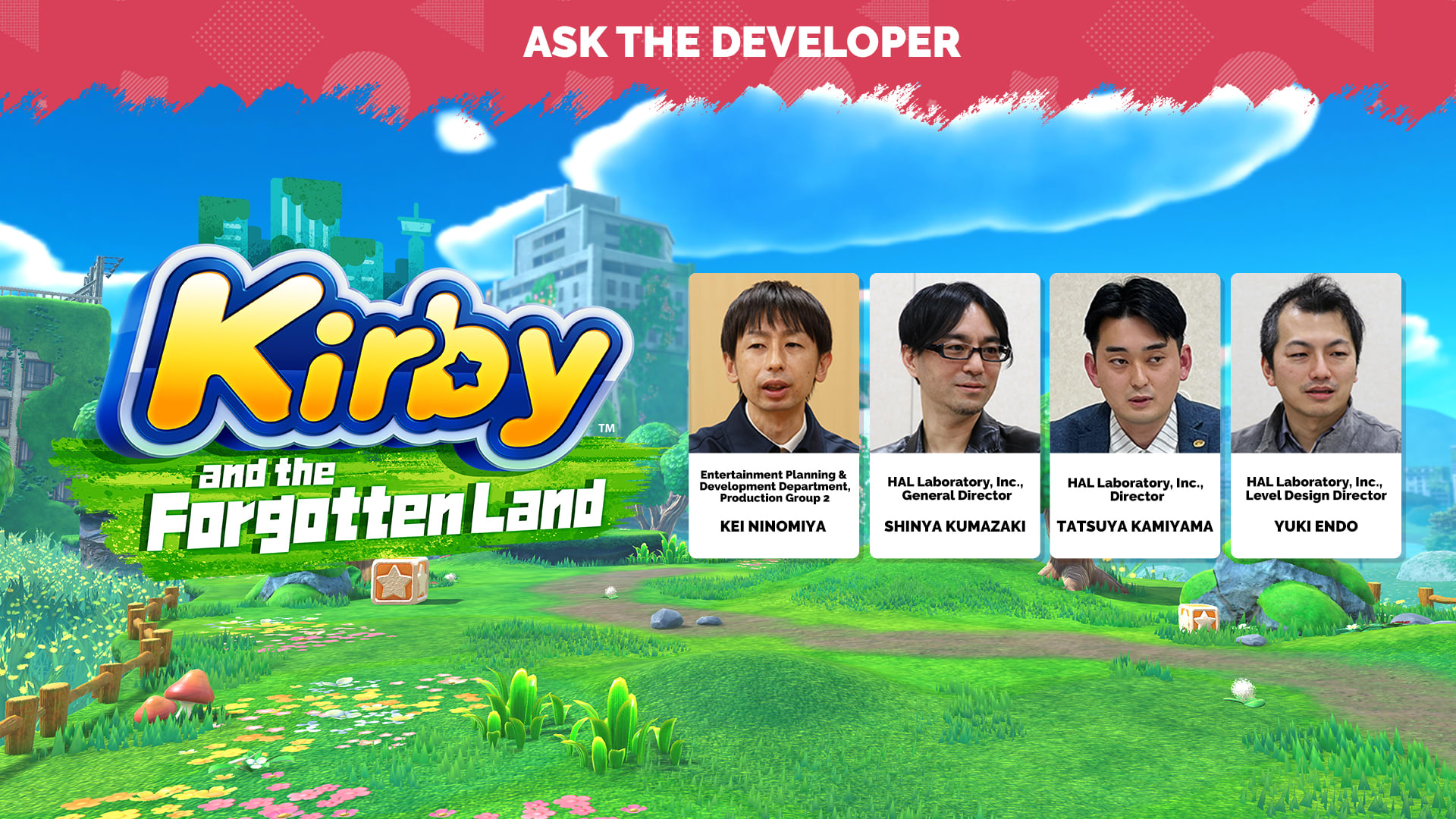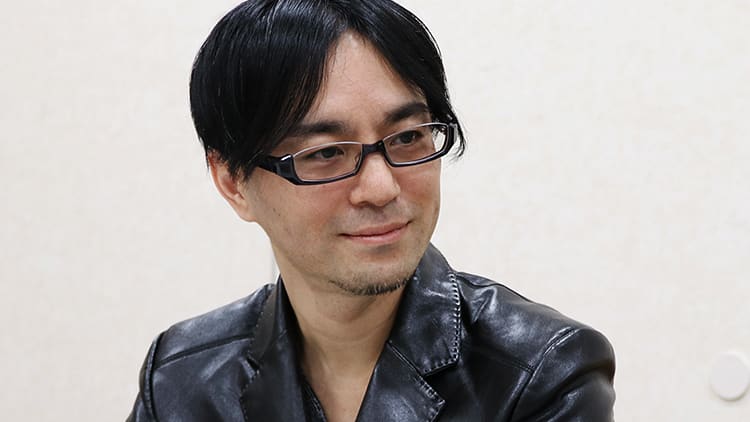
Ask the Developer Vol. 4, Kirby and the Forgotten Land–Part 3
Content pre-recorded in accordance with current COVID-19 health and safety guidelines.
This article has been translated from the original Japanese content.
Contents
1: Why aren't the stages more densely populated?
2: I can't believe this is the first mainline 3D Kirby title!
3: Just an extra bit of "flavor"
Part 3: Just an extra bit of "flavor"
We've discussed the adjustments you made to better accommodate 3D gameplay, but the transition also brought with it new gameplay elements that could only be done in 3D, right
Ninomiya: There's a new ability in this game called Mouthful Mode. Kirby can now inhale large objects like cars or traffic cones, then change form and take on the characteristics of whichever thing he swallowed.
Kumazaki: Near the beginning of development, we spent a lot of time discussing the kinds of movement and visuals we could add that might feel unique to Kirby—ones that you wouldn't find in other 3D platformers. Then we thought about Kirby's unique characteristics and realized that, to make a truly great 3D platformer, we should embrace his innate humor. He's this funny little puffball, always changing shape, squashing and stretching as he gobbles up everything around him.
Ninomiya: Nintendo was also thinking about Kirby's moves at the same time, and they suggested having an ability where he can inhale objects that he can't normally inhale. Same idea, same time. Pure coincidence. When Kirby uses his new Mouthful Mode, he doesn't gain a Copy Ability to match what he swallowed like usual. He's unable to swallow the object in his mouth, so he takes its shape instead, then performs moves related to the object. It seemed like a quirky idea with equally quirky visuals. In other words, it felt like a good fit for Kirby.
Endo: From the perspective of creating new gameplay experiences, Mouthful Mode had a kind of intuitive visual appeal for our players. There were all kinds of new possibilities, from swallowing a large metal ring so that Kirby can puff out gusts of wind to propel his boat, to swallowing a large pipe and rolling forward to defeat an entire line of enemies.
Ninomiya: It was also appealing to us in terms of visual design. Because it would be in 3D, we imagined seeing Kirby in these bizarre shapes from all kinds of angles.
What kind of discussions did you have about the objects Kirby could use in his new Mouthful Mode?
Ninomiya: We wanted to pick objects that are common to humans but unknown to Kirby. So things with familiar forms of movement, like a car, or familiar things we can picture in our everyday lives, like pipes. I thought we should incorporate gameplay that has Kirby inhaling these objects and bringing them to life. That's where the concept of a world with a forgotten civilization came from, with things like cars and pipes lying around.
I see! So you determined the setting for this new game by finding a unique form of 3D gameplay for Kirby, then you built a world around it... The world you built for this game seems quite different from the relatively peaceful settings of Kirby's previous adventures. Could you speak a bit more about your thinking there?
Kamiyama: Well, we did speak with our designers on a regular basis to make sure this game's new world didn't seem too scary. Abandoned ruins can make you feel like you're playing a horror game, so we had to be careful. In order to blend this setting with Kirby's usual style, we added a bright blue sky and colorful plant life, like grass and flowers.
Kumazaki: Rather than decaying ruins with evidence of an ancient human civilization, you explore ruins that show the prosperity and joy of what once was. We tried to make it seem like a beautiful place that has merged with nature, even though the people that built it are nowhere to be found.
Kamiyama: We also realized that we could only bring familiar elements from earlier Kirby games into this new title if they matched the new setting. We didn't include things like flying islands that float up and down, for example. If the scenery around you moves or changes, it's not because of some magical force. Instead, we might show you that a machine is moving the platform with chains. Our goal was to avoid major inconsistencies with the real world. Our designers also had the idea to add billboards and signage written in the local language. Little things like that give players the sense that this world was a fun place to live, once upon a time.
Now that you mention it, I do recall a shopping-mall sign with some kind of text on it...

Kumazaki: We did create a new written language for our forgotten civilization, but we made sure each message could be deciphered if the player studies them closely. The game also features a song performed in the local language—a recording that was a huge hit in the past—and we wrote out the lyrics so that, if you decipher them, they match the setting of this game as well. This is just an extra bit of "flavor" in the game's world, but it also allows players who want to learn more the chance to immerse themselves in the adventure. I feel this is where the creators' efforts really pay off.

Ninomiya: Since we made this new language up ourselves, every player is guaranteed to hear the song in an unknown language, no matter what their native tongue may be. You first hear the song shortly after Kirby travels to this different world. Kirby is wondering what kind of place this might be, feeling a mix of concern and excitement. The song, performed in an unknown language, helps the player sympathize with Kirby. It was an experiment that turned out rather well, I think.
In this new game, you get to explore a shopping mall, a theme park, and much more. Everything about the design of these stages feels completely different from earlier games in the series. How did you approach their creation?
Endo: The 3D gameplay is how we arrived at the "forgotten civilization" concept, but when it came to
building each individual stage, we had ideas that were also born from a gameplay-first focus, as well as ideas that started as visual designs. Either way, we aimed to create new stages with gameplay that would take players on an emotional journey. That said, for the stages where we started with the design, finding the right gameplay to match proved to be quite challenging. After thinking about it too much, we ended up with a shopping mall with escalators everywhere! (Laughs)
Kumazaki: I asked our team to make the game's shopping mall look like a real-world mall. The realistic touches make that stage more relatable and the game itself more immersive.
Endo: So we dialed back the escalators and designed around gameplay that requires the player to use a map of the mall and the surrounding signage to solve puzzles and explore the full stage. Another example is the theme park stage. We added in some gameplay there where Kirby joins a line of parade floats and moves along with it. So, we've been able to create various new gameplay experiences out of the visual design aspects.
Ninomiya: I thought it would be nice if the gameplay in each stage felt unique, so I provided a number of comments and ideas from my side as I played new prototypes. We consulted with the staff at HAL Laboratory to make sure each stage leaves a deep impression on the player. It was a real collaborative effort.
I see. So, in summary, while the larger setting was inspired by Kirby as a character, you crafted the details of that world with both design and gameplay in mind.
